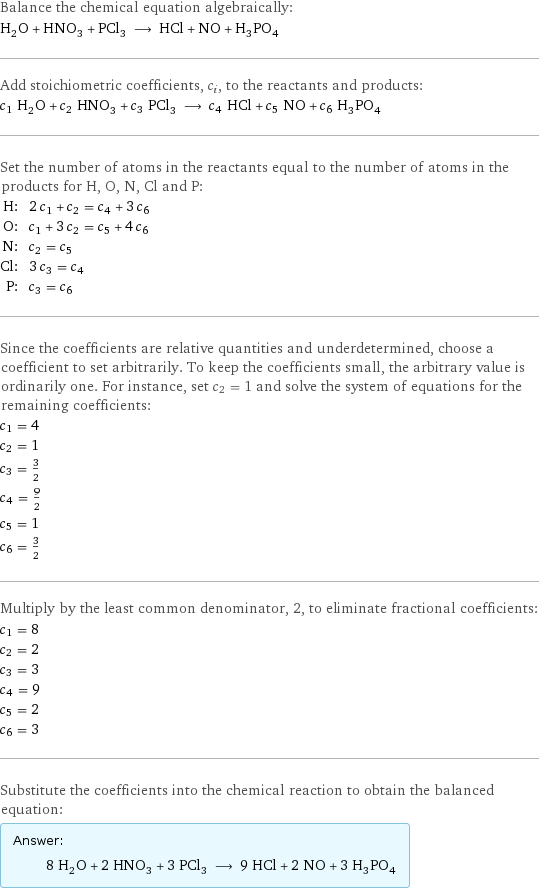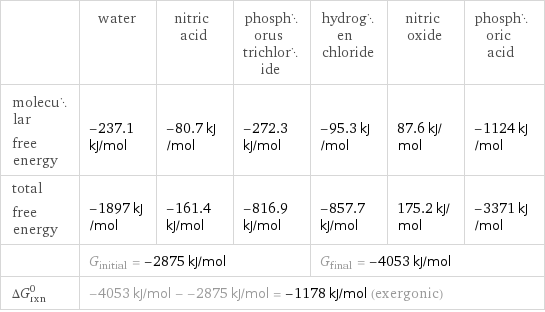Input interpretation

H_2O water + HNO_3 nitric acid + PCl_3 phosphorus trichloride ⟶ HCl hydrogen chloride + NO nitric oxide + H_3PO_4 phosphoric acid
Balanced equation

Balance the chemical equation algebraically: H_2O + HNO_3 + PCl_3 ⟶ HCl + NO + H_3PO_4 Add stoichiometric coefficients, c_i, to the reactants and products: c_1 H_2O + c_2 HNO_3 + c_3 PCl_3 ⟶ c_4 HCl + c_5 NO + c_6 H_3PO_4 Set the number of atoms in the reactants equal to the number of atoms in the products for H, O, N, Cl and P: H: | 2 c_1 + c_2 = c_4 + 3 c_6 O: | c_1 + 3 c_2 = c_5 + 4 c_6 N: | c_2 = c_5 Cl: | 3 c_3 = c_4 P: | c_3 = c_6 Since the coefficients are relative quantities and underdetermined, choose a coefficient to set arbitrarily. To keep the coefficients small, the arbitrary value is ordinarily one. For instance, set c_2 = 1 and solve the system of equations for the remaining coefficients: c_1 = 4 c_2 = 1 c_3 = 3/2 c_4 = 9/2 c_5 = 1 c_6 = 3/2 Multiply by the least common denominator, 2, to eliminate fractional coefficients: c_1 = 8 c_2 = 2 c_3 = 3 c_4 = 9 c_5 = 2 c_6 = 3 Substitute the coefficients into the chemical reaction to obtain the balanced equation: Answer: | | 8 H_2O + 2 HNO_3 + 3 PCl_3 ⟶ 9 HCl + 2 NO + 3 H_3PO_4
Structures

+ + ⟶ + +
Names

water + nitric acid + phosphorus trichloride ⟶ hydrogen chloride + nitric oxide + phosphoric acid
Reaction thermodynamics
Gibbs free energy

| water | nitric acid | phosphorus trichloride | hydrogen chloride | nitric oxide | phosphoric acid molecular free energy | -237.1 kJ/mol | -80.7 kJ/mol | -272.3 kJ/mol | -95.3 kJ/mol | 87.6 kJ/mol | -1124 kJ/mol total free energy | -1897 kJ/mol | -161.4 kJ/mol | -816.9 kJ/mol | -857.7 kJ/mol | 175.2 kJ/mol | -3371 kJ/mol | G_initial = -2875 kJ/mol | | | G_final = -4053 kJ/mol | | ΔG_rxn^0 | -4053 kJ/mol - -2875 kJ/mol = -1178 kJ/mol (exergonic) | | | | |
Equilibrium constant
![Construct the equilibrium constant, K, expression for: H_2O + HNO_3 + PCl_3 ⟶ HCl + NO + H_3PO_4 Plan: • Balance the chemical equation. • Determine the stoichiometric numbers. • Assemble the activity expression for each chemical species. • Use the activity expressions to build the equilibrium constant expression. Write the balanced chemical equation: 8 H_2O + 2 HNO_3 + 3 PCl_3 ⟶ 9 HCl + 2 NO + 3 H_3PO_4 Assign stoichiometric numbers, ν_i, using the stoichiometric coefficients, c_i, from the balanced chemical equation in the following manner: ν_i = -c_i for reactants and ν_i = c_i for products: chemical species | c_i | ν_i H_2O | 8 | -8 HNO_3 | 2 | -2 PCl_3 | 3 | -3 HCl | 9 | 9 NO | 2 | 2 H_3PO_4 | 3 | 3 Assemble the activity expressions accounting for the state of matter and ν_i: chemical species | c_i | ν_i | activity expression H_2O | 8 | -8 | ([H2O])^(-8) HNO_3 | 2 | -2 | ([HNO3])^(-2) PCl_3 | 3 | -3 | ([PCl3])^(-3) HCl | 9 | 9 | ([HCl])^9 NO | 2 | 2 | ([NO])^2 H_3PO_4 | 3 | 3 | ([H3PO4])^3 The equilibrium constant symbol in the concentration basis is: K_c Mulitply the activity expressions to arrive at the K_c expression: Answer: | | K_c = ([H2O])^(-8) ([HNO3])^(-2) ([PCl3])^(-3) ([HCl])^9 ([NO])^2 ([H3PO4])^3 = (([HCl])^9 ([NO])^2 ([H3PO4])^3)/(([H2O])^8 ([HNO3])^2 ([PCl3])^3)](../image_source/4111ccb1c9cd9e952aff1e1ef6ca132a.png)
Construct the equilibrium constant, K, expression for: H_2O + HNO_3 + PCl_3 ⟶ HCl + NO + H_3PO_4 Plan: • Balance the chemical equation. • Determine the stoichiometric numbers. • Assemble the activity expression for each chemical species. • Use the activity expressions to build the equilibrium constant expression. Write the balanced chemical equation: 8 H_2O + 2 HNO_3 + 3 PCl_3 ⟶ 9 HCl + 2 NO + 3 H_3PO_4 Assign stoichiometric numbers, ν_i, using the stoichiometric coefficients, c_i, from the balanced chemical equation in the following manner: ν_i = -c_i for reactants and ν_i = c_i for products: chemical species | c_i | ν_i H_2O | 8 | -8 HNO_3 | 2 | -2 PCl_3 | 3 | -3 HCl | 9 | 9 NO | 2 | 2 H_3PO_4 | 3 | 3 Assemble the activity expressions accounting for the state of matter and ν_i: chemical species | c_i | ν_i | activity expression H_2O | 8 | -8 | ([H2O])^(-8) HNO_3 | 2 | -2 | ([HNO3])^(-2) PCl_3 | 3 | -3 | ([PCl3])^(-3) HCl | 9 | 9 | ([HCl])^9 NO | 2 | 2 | ([NO])^2 H_3PO_4 | 3 | 3 | ([H3PO4])^3 The equilibrium constant symbol in the concentration basis is: K_c Mulitply the activity expressions to arrive at the K_c expression: Answer: | | K_c = ([H2O])^(-8) ([HNO3])^(-2) ([PCl3])^(-3) ([HCl])^9 ([NO])^2 ([H3PO4])^3 = (([HCl])^9 ([NO])^2 ([H3PO4])^3)/(([H2O])^8 ([HNO3])^2 ([PCl3])^3)
Rate of reaction
![Construct the rate of reaction expression for: H_2O + HNO_3 + PCl_3 ⟶ HCl + NO + H_3PO_4 Plan: • Balance the chemical equation. • Determine the stoichiometric numbers. • Assemble the rate term for each chemical species. • Write the rate of reaction expression. Write the balanced chemical equation: 8 H_2O + 2 HNO_3 + 3 PCl_3 ⟶ 9 HCl + 2 NO + 3 H_3PO_4 Assign stoichiometric numbers, ν_i, using the stoichiometric coefficients, c_i, from the balanced chemical equation in the following manner: ν_i = -c_i for reactants and ν_i = c_i for products: chemical species | c_i | ν_i H_2O | 8 | -8 HNO_3 | 2 | -2 PCl_3 | 3 | -3 HCl | 9 | 9 NO | 2 | 2 H_3PO_4 | 3 | 3 The rate term for each chemical species, B_i, is 1/ν_i(Δ[B_i])/(Δt) where [B_i] is the amount concentration and t is time: chemical species | c_i | ν_i | rate term H_2O | 8 | -8 | -1/8 (Δ[H2O])/(Δt) HNO_3 | 2 | -2 | -1/2 (Δ[HNO3])/(Δt) PCl_3 | 3 | -3 | -1/3 (Δ[PCl3])/(Δt) HCl | 9 | 9 | 1/9 (Δ[HCl])/(Δt) NO | 2 | 2 | 1/2 (Δ[NO])/(Δt) H_3PO_4 | 3 | 3 | 1/3 (Δ[H3PO4])/(Δt) (for infinitesimal rate of change, replace Δ with d) Set the rate terms equal to each other to arrive at the rate expression: Answer: | | rate = -1/8 (Δ[H2O])/(Δt) = -1/2 (Δ[HNO3])/(Δt) = -1/3 (Δ[PCl3])/(Δt) = 1/9 (Δ[HCl])/(Δt) = 1/2 (Δ[NO])/(Δt) = 1/3 (Δ[H3PO4])/(Δt) (assuming constant volume and no accumulation of intermediates or side products)](../image_source/e0c75460db0189571e9e9e76d9da4be1.png)
Construct the rate of reaction expression for: H_2O + HNO_3 + PCl_3 ⟶ HCl + NO + H_3PO_4 Plan: • Balance the chemical equation. • Determine the stoichiometric numbers. • Assemble the rate term for each chemical species. • Write the rate of reaction expression. Write the balanced chemical equation: 8 H_2O + 2 HNO_3 + 3 PCl_3 ⟶ 9 HCl + 2 NO + 3 H_3PO_4 Assign stoichiometric numbers, ν_i, using the stoichiometric coefficients, c_i, from the balanced chemical equation in the following manner: ν_i = -c_i for reactants and ν_i = c_i for products: chemical species | c_i | ν_i H_2O | 8 | -8 HNO_3 | 2 | -2 PCl_3 | 3 | -3 HCl | 9 | 9 NO | 2 | 2 H_3PO_4 | 3 | 3 The rate term for each chemical species, B_i, is 1/ν_i(Δ[B_i])/(Δt) where [B_i] is the amount concentration and t is time: chemical species | c_i | ν_i | rate term H_2O | 8 | -8 | -1/8 (Δ[H2O])/(Δt) HNO_3 | 2 | -2 | -1/2 (Δ[HNO3])/(Δt) PCl_3 | 3 | -3 | -1/3 (Δ[PCl3])/(Δt) HCl | 9 | 9 | 1/9 (Δ[HCl])/(Δt) NO | 2 | 2 | 1/2 (Δ[NO])/(Δt) H_3PO_4 | 3 | 3 | 1/3 (Δ[H3PO4])/(Δt) (for infinitesimal rate of change, replace Δ with d) Set the rate terms equal to each other to arrive at the rate expression: Answer: | | rate = -1/8 (Δ[H2O])/(Δt) = -1/2 (Δ[HNO3])/(Δt) = -1/3 (Δ[PCl3])/(Δt) = 1/9 (Δ[HCl])/(Δt) = 1/2 (Δ[NO])/(Δt) = 1/3 (Δ[H3PO4])/(Δt) (assuming constant volume and no accumulation of intermediates or side products)
Chemical names and formulas

| water | nitric acid | phosphorus trichloride | hydrogen chloride | nitric oxide | phosphoric acid formula | H_2O | HNO_3 | PCl_3 | HCl | NO | H_3PO_4 Hill formula | H_2O | HNO_3 | Cl_3P | ClH | NO | H_3O_4P name | water | nitric acid | phosphorus trichloride | hydrogen chloride | nitric oxide | phosphoric acid IUPAC name | water | nitric acid | trichlorophosphane | hydrogen chloride | nitric oxide | phosphoric acid